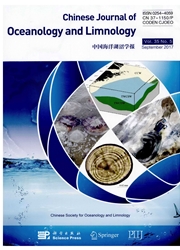

 中文摘要:
中文摘要:
Diatoms are widely used to study past and present changes in the marine environment. Unimodal models are appropriate for exploring the relationship between environmental properties in Chinese inshore waters and fossil diatom species derived from modern surface sediments. The best-fit relationships between two multivariate datasets(diatom species and environmental variables) were identified using canonical correspondence analysis(CCA), which is a constrained ordination technique. The absolute abundance of diatoms in the Chinese inshore waters ranged from 500 to 48 000 valves/g, and the average absolute abundance of all the 29 sites was 11 300 valves/g. 153 species and varieties of diatoms belonging to 42 genera in all were identified in the Chinese inshore waters. There were 28 dominant diatom species in all. According to the absolute abundance of the dominant species and the spatial distribution of the currents from the Chinese inshore waters, 12 diatom assemblages were distinguished from north to south, which refl ected the different oceanographic conditions at the regional scale. Of the eight environmental variables considered, the most important environmental variable is winter sea surface salinity(WSS), which was also the only environmental variable with statistical significance. Therefore, it may be used to establish a transfer functions for the Chinese inshore waters in future paleoclimate studies.
 英文摘要:
英文摘要:
Diatoms are widely used to study past and present changes in the marine environment. Unimodal models are appropriate for exploring the relationship between environmental properties in Chinese inshore waters and fossil diatom species derived from modem surface sediments. The best-fit relationships between two multivariate datasets (diatom species and environmental variables) were identified using canonical correspondence analysis (CCA), which is a constrained ordination technique. The absolute abundance of diatoms in the Chinese inshore waters ranged from 500 to 48 000 valves/g, and the average absolute abundance of all the 29 sites was l l 300 valves/g. 153 species and varieties of diatoms belonging to 42 genera in all were identified in the Chinese inshore waters. There were 28 dominant diatom species in all. According to the absolute abundance of the dominant species and the spatial distribution of the currents from the Chinese inshore waters, 12 diatom assemblages were distinguished from north to south, which reflected the different oceanographic conditions at the regional scale. Of the eight environmental variables considered, the most important environmental variable is winter sea surface salinity (WSS), which was also the only environmental variable with statistical significance. Therefore, it may be used to establish a transfer functions for the Chinese inshore waters in future paleoclimate studies.
 同期刊论文项目
同期刊论文项目
 同项目期刊论文
同项目期刊论文
 期刊信息
期刊信息
